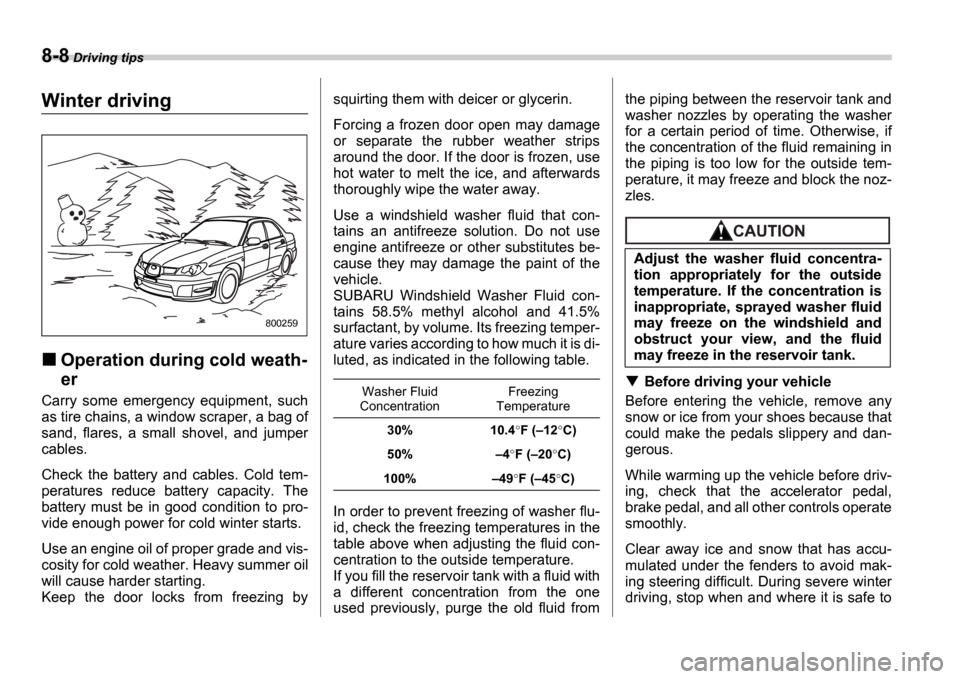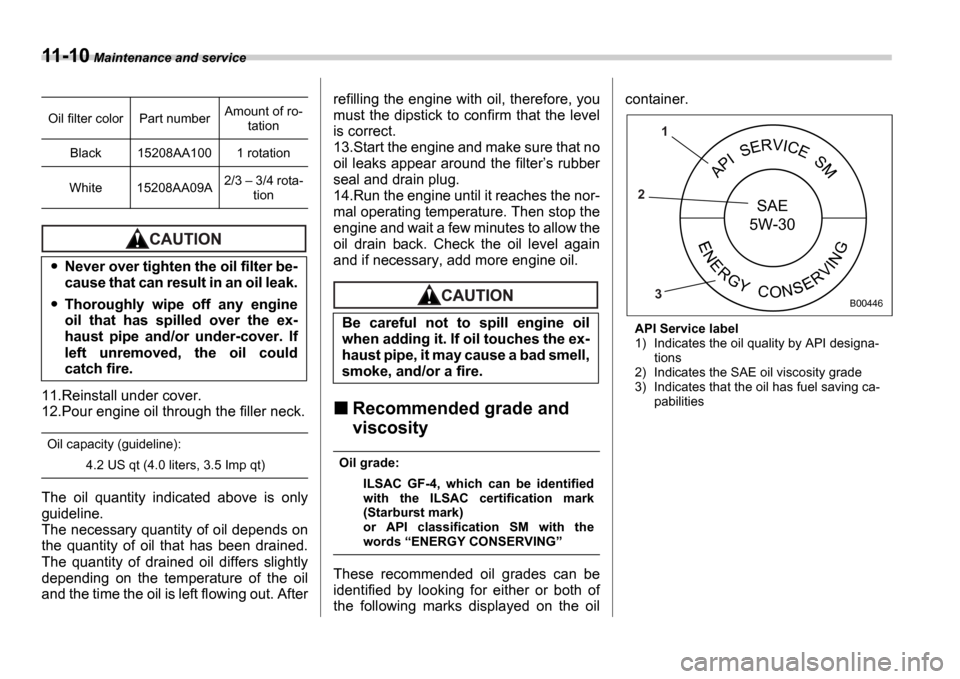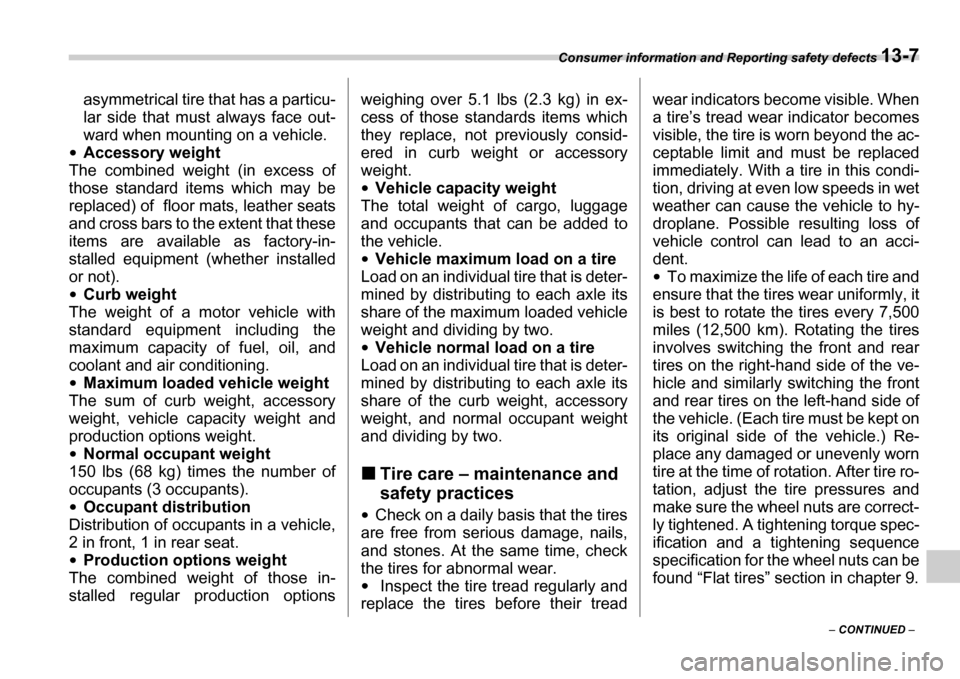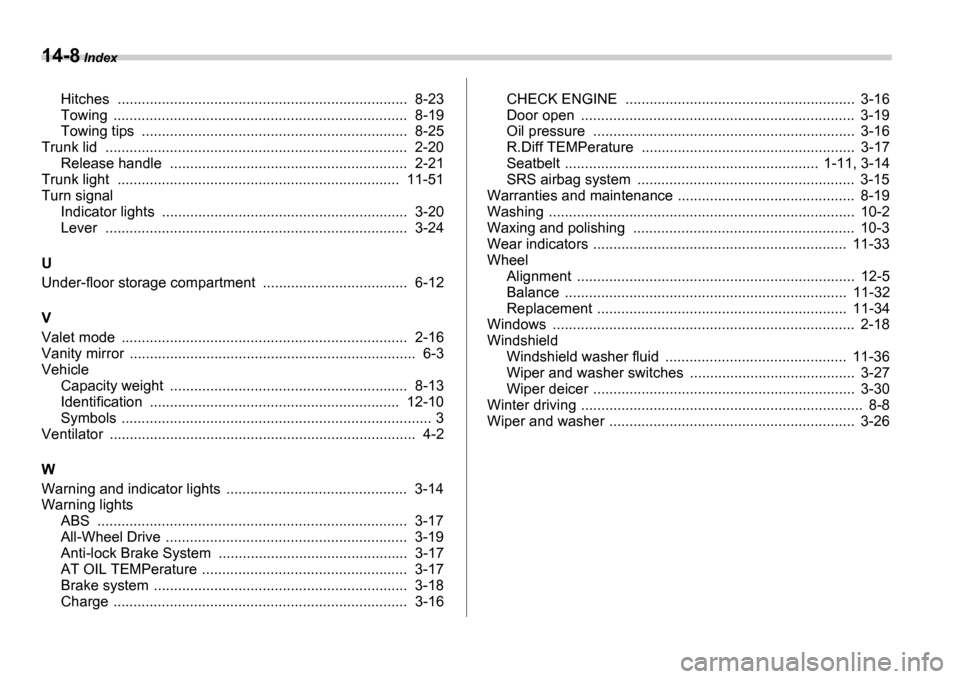2006 SUBARU IMPREZA oil capacity
[x] Cancel search: oil capacityPage 235 of 365

8-8 Driving tips
Winter driving
Operation during cold weath-
er
Carry some emergency equipment, such
as tire chains, a window scraper, a bag of
sand, flares, a small shovel, and jumper
cables.
Check the battery and cables. Cold tem-
peratures reduce battery capacity. The
battery must be in good condition to pro-
vide enough power for cold winter starts.
Use an engine oil of proper grade and vis-
cosity for cold weather. Heavy summer oil
will cause harder starting.
Keep the door locks from freezing by squirting them with deicer or glycerin.
Forcing a frozen door open may damage
or separate the rubber weather strips
around the door. If the door is frozen, use
hot water to melt the ice, and afterwards
thoroughly wipe the water away.
Use a windshield washer fluid that con-
tains an antifreeze solution. Do not use
engine antifreeze or other substitutes be-
cause they may damage the paint of the
vehicle.
SUBARU Windshield Washer Fluid con-
tains 58.5% methyl alcohol and 41.5%
surfactant, by volume. Its freezing temper-
ature varies according to how much it is di-
luted, as indicated in the following table.
In order to prevent freezing of washer flu-
id, check the freezing temperatures in the
table above when adjusting the fluid con-
centration to the outside temperature.
If you fill the reservoir tank with a fluid with
a different concentration from the one
used previously, purge the old fluid fromthe piping between the reservoir tank and
washer nozzles by operating the washer
for a certain period of time. Otherwise, if
the concentration of the fluid remaining in
the piping is too low for the outside tem-
perature, it may freeze and block the noz-
zles.
Before driving your vehicle
Before entering the vehicle, remove any
snow or ice from your shoes because that
could make the pedals slippery and dan-
gerous.
While warming up the vehicle before driv-
ing, check that the accelerator pedal,
brake pedal, and all other controls operate
smoothly.
Clear away ice and snow that has accu-
mulated under the fenders to avoid mak-
ing steering difficult. During severe winter
driving, stop when and where it is safe to
800259
Washer Fluid
Concentration Freezing
Temperature
30% 10.4 F ( 12 C)
50% 4F ( 20 C)
100% 49 F ( 45 C)
Adjust the washer fluid concentra-
tion appropriately for the outside
temperature. If the concentration is
inappropriate, sprayed washer fluid
may freeze on the windshield and
obstruct your view, and the fluid
may freeze in the reservoir tank.
Page 289 of 365

11-10 Maintenance and service
11.Reinstall under cover.
12.Pour engine oil through the filler neck.
Oil capacity (guideline):
4.2 US qt (4.0 liters, 3.5 Imp qt)
The oil quantity indicated above is only
guideline.
The necessary quantity of oil depends on
the quantity of oil that has been drained.
The quantity of drained oil differs slightly
depending on the temperature of the oil
and the time the oil is left flowing out. After refilling the engine with oil, therefore, you
must the dipstick to confirm that the level
is correct.
13.Start the engine and make sure that no
oil leaks appear around the filter
s rubber
seal and drain plug.
14.Run the engine until it reaches the nor-
mal operating temperature. Then stop the
engine and wait a few minutes to allow the
oil drain back. Check the oil level again
and if necessary, add more engine oil.
Recommended grade and
viscosity
Oil grade:
ILSAC GF-4, which can be identified
with the ILSAC certification mark
(Starburst mark)
or API classification SM with the
words ENERGY CONSERVING
These recommended oil grades can be
identified by looking for either or both of
the following marks displayed on the oil container.
API Service label
1) Indicates the oil quality by API designa-
tions
2) Indicates the SAE oil viscosity grade
3) Indicates that the oil has fuel saving ca- pabilities
Oil filter color Part number
Amount of ro-
tation
Black 15208AA100 1 rotation
White 15208AA09A 2/3
3/4 rota-
tion
Never over tighten the oil filter be-
cause that can result in an oil leak.
Thoroughly wipe off any engine
oil that has spilled over the ex-
haust pipe and/or under-cover. If
left unremoved, the oil could
catch fire.
Be careful not to spill engine oil
when adding it. If oil touches the ex-
haust pipe, it may cause a bad smell,
smoke, and/or a fire.
APISERVICES
NERGYCONRVING
SAE
5W-30
1
2
3
B00446
Page 348 of 365

Consumer information and Reporting safety defects 13-7
CONTINUED
asymmetrical tire that has a particu-
lar side that must always face out-
ward when mounting on a vehicle.
Accessory weight
The combined weight (in excess of
those standard items which may be
replaced) of floor mats, leather seats
and cross bars to the extent that these
items are available as factory-in-
stalled equipment (whether installed
or not).
Curb weight
The weight of a motor vehicle with
standard equipment including the
maximum capacity of fuel, oil, and
coolant and air conditioning.
Maximum loaded vehicle weight
The sum of curb weight, accessory
weight, vehicle capacity weight and
production options weight.
Normal occupant weight
150 lbs (68 kg) times the number of
occupants (3 occupants).
Occupant distribution
Distribution of occupants in a vehicle,
2 in front, 1 in rear seat.
Production options weight
The combined weight of those in-
stalled regular production options weighing over 5.1 lbs (2.3 kg) in ex-
cess of those standards items which
they replace, not previously consid-
ered in curb weight or accessory
weight.
Vehicle capacity weight
The total weight of cargo, luggage
and occupants that can be added to
the vehicle.
Vehicle maximum load on a tire
Load on an individual tire that is deter-
mined by distributing to each axle its
share of the maximum loaded vehicle
weight and dividing by two.
Vehicle normal load on a tire
Load on an individual tire that is deter-
mined by distributing to each axle its
share of the curb weight, accessory
weight, and normal occupant weight
and dividing by two.
Tire care maintenance and
safety practices
Check on a daily basis that the tires
are free from serious damage, nails,
and stones. At the same time, check
the tires for abnormal wear.
Inspect the tire tread regularly and
replace the tires before their tread wear indicators become visible. When
a tire
s tread wear indicator becomes
visible, the tire is worn beyond the ac-
ceptable limit and must be replaced
immediately. With a tire in this condi-
tion, driving at even low speeds in wet
weather can cause the vehicle to hy-
droplane. Possible resulting loss of
vehicle control can lead to an acci-
dent.
To maximize the life of each tire and
ensure that the tires wear uniformly, it
is best to rotate the tires every 7,500
miles (12,500 km). Rotating the tires
involves switching the front and rear
tires on the right-hand side of the ve-
hicle and similarly switching the front
and rear tires on the left-hand side of
the vehicle. (Each tire must be kept on
its original side of the vehicle.) Re-
place any damaged or unevenly worn
tire at the time of rotation. After tire ro-
tation, adjust the tire pressures and
make sure the wheel nuts are correct-
ly tightened. A tightening torque spec-
ification and a tightening sequence
specification for the wheel nuts can be
found Flat tires section in chapter 9.
Page 363 of 365

14-8 Index
Hitches ............................................. ........................... 8-23
Towing ............................................ ............................. 8-19
Towing tips ........................................ .......................... 8-25
Trunk lid .......................................... ................................. 2-20
Release handle ..................................... ...................... 2-21
Trunk light ........................................ .............................. 11-51
Turn signal
Indicator lights .................................... ......................... 3-20
Lever .............................................. ............................. 3-24
U
Under-floor storage compartment ..................... ............... 6-12
V
Valet mode ........................................ ............................... 2-16
Vanity mirror ...................................... ................................. 6-3
Vehicle Capacity weight ..................................... ...................... 8-13
Identification ..................................... ......................... 12-10
Symbols ............................................ ................................. 3
Ventilator ........................................ .................................... 4-2
W
Warning and indicator lights ........................ ..................... 3-14
Warning lights
ABS ............................................... .............................. 3-17
All-Wheel Drive .................................... ........................ 3-19
Anti-lock Brake System ................................ ............... 3-17
AT OIL TEMPerature ................................ ................... 3-17
Brake system ......................................... ...................... 3-18
Charge ............................................ ............................. 3-16CHECK ENGINE ......................................
................... 3-16
Door open ......................................... ........................... 3-19
Oil pressure ....................................... .......................... 3-16
R.Diff TEMPerature ................................ ..................... 3-17
Seatbelt .......................................... ..................... 1-11, 3-14
SRS airbag system ................................... ................... 3-15
Warranties and maintenance .......................... .................. 8-19
Washing ............................................ ................................ 10-2
Waxing and polishing .............................. ......................... 10-3
Wear indicators ..................................... .......................... 11-33
Wheel Alignment ......................................... ............................ 12-5
Balance ............................................ .......................... 11-32
Replacement ....................................... ....................... 11-34
Windows ............................................ ............................... 2-18
Windshield Windshield washer fluid ............................ ................. 11-36
Wiper and washer switches ............................. ............ 3-27
Wiper deicer ....................................... .......................... 3-30
Winter driving ..................................... ................................. 8-8
Wiper and washer ................................... .......................... 3-26
Page 365 of 365

GAS STATION REFERENCE
Fuel:
2.5-liter non-turbo models
Use only unleaded gasoline with an octane rating of 87 AKI or
higher.
WRX
Use premium unleaded gasoline with an octane rating of 91 AKI or
higher. If premium unleaded gasoline with an octane r ating of 91
AKI is not available, regular unleaded gasoline with octane rating
of 87 AKI or higher may be temporarily used. For opti mum engine
performance and driveability, it is required that you use premium
grade unleaded gasoline with an octane rating of 91 AKI or higher.
WRX-STI
Use super-premium unleaded gasoline with an octane rat ing of 93
AKI or higher. If super-premium unleaded gasoline wi th an octane
rating of 93 AKI is not available, premium unleaded g asoline with
octane rating of 91 AKI or higher may be temporarily u sed. For op-
timum engine performance and driveability, it is requir ed that you
use super-premium grade unleaded gasoline with an oct ane ratingof 93 AKI or higher.
Fuel octane rating
This octane rating is the average of the Research Octane
and Mo-
tor Octane numbers and is commonly referred to as the An ti Knock
Index (AKI). Refer to Fuel section in this manual.
Fuel capacity:
15.9 US gal (60 liters, 13.2 Imp gal)
Engine oil:
Use only API classification SM with the words ENERGY CON-
SERVING and the ILSAC certification mark (starburst mark) dis-
played on the container.
Engine oil capacity:
4.2 US qt (4.0 liters, 3.5 Imp qt)
Cold tire pressure:
Item 2.5i, OUTBACK SPORT WRX WRX-STI
Tire size P205/55R16 89V 215/45R17 91W 225/45R17 90W
Wheel size 16 6 1
/2 JJ 17
7 JJ 17 8 JJ
Pressure Front 33 psi (230 kPa, 2.3 kgf/cm 2
) 33 psi (230 kPa, 2.3 kgf/cm 2
) 36 psi (250 kPa, 2.5 kgf/cm 2
)
Rear 30 psi (210 kPa, 2.1 kgf/cm 2
) 32 psi (220 kPa, 2.2 kgf/cm 2
) 30 psi (210 kPa, 2.1 kgf/cm 2
)
Temporary spare
tire Size
T135/70 D16 T135/70 D17
Pressure 60 psi (420 kPa, 4.2 kgf/cm2
)